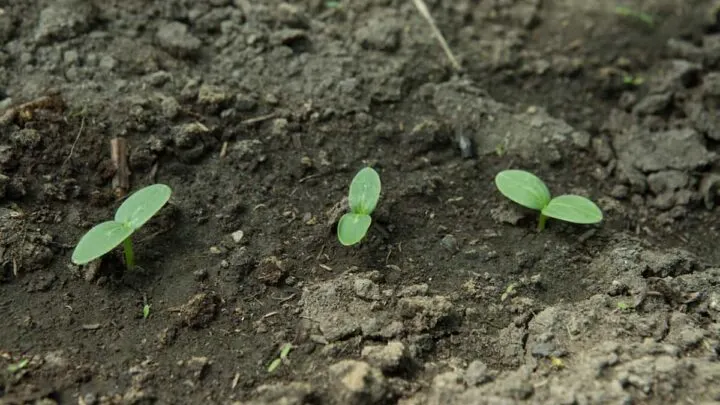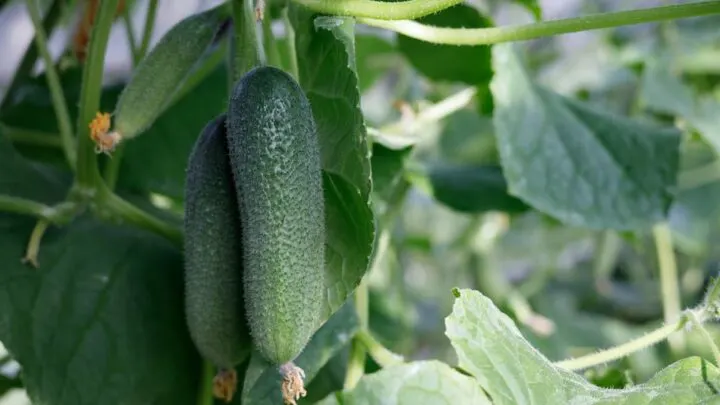Cucumbers are among the top 3 favorite plants to have in everyone’s gardens. Along with tomatoes and peppers, cucumbers are beloved by millions yearly. They are easy to grow, and they have a fantastic yield if grown in the right conditions. Sometimes they may take a while to produce and for many new gardeners, the question is usually; why are my cucumber plants growing slow?
Cucumbers grow slow for many reasons including being planted too early, lacking nutrients, and not having the proper spacing. Container cucumbers are more susceptible to slow growth. Pests can also play a significant role in stunted cucumber growth.
Cucumbers grow rather quickly, usually ready for harvest in 50-70 days, depending on the variety. If you notice your cucumbers growing very slowly, then something isn’t right with their conditions.
Below you will find all the information on why cucumber plants may grow slowly. We will discuss how we solve this issue and how your yield might be affected.

Causes Of Slow Growth In Cucumber Plants
Cucumber plants grow slowly because they usually lack something they need, or the conditions aren’t right for them to thrive. Let’s take a look.
Planted Too Early
One of the main reasons your cucumber plants seem to be taking a while to grow may be because you planted your plants too early. It is one of the most common mistakes people make when planting cucumbers.
Cucumbers are hot-temperature vegetables. They need the soil to be at least 70 degrees for the seeds to germinate. They are also not tolerant to frost, so they must be planted two weeks after the last frost date to thrive. People often put their cucumbers in the ground in the early spring, and the plants do not have the heat they need to grow properly.
Spacing
If you know how a cucumber grows, you understand that cucumber plants are vine plants that really like to stretch out.
Cucumbers need 30-60 inches between each plant because they need that space for their roots to grow and stretch out. If they do not have this soil space, it may take them longer to grow, and they may never grow to their full potential.
Weather
Apart from planting too early, you must keep the weather in mind. We know now that cucumber plants need to be planted two weeks after the last frost date. However, you must also ensure the outside temperature is consistently around 70 degrees.
Cucumber plants need temperatures of around 70-90 degrees if they are going to thrive. If the temperatures are above or below this range, it can stress out the cucumber plant drastically, and they may grow very slowly.
Lack of Nutrients
Another huge reason your cucumber plants grow slowly is that they lack nutrients. Like you and I, we need nutrients to fuel our lives to grow and stay healthy. Plants are much the same, including cucumbers. Without a steady flow of nutrients, cucumber plants will take much longer to grow.
Too Much or Not Enough Water
Water is another source that greatly affects how cucumber plants grow. They are slightly particular about their water intake and need the right amount to grow as they are supposed to.
Too much water will cause the roots to get waterlogged, which means nutrients and oxygen can’t flow through the stems, leaving the plants to grow slowly. Too little water will also disrupt the flow of nutrients and oxygen that needs to go through the plant.

Powdery Mildew
Powdery mildew is a fungal disease that is very common in gardens. It will affect almost every plant but isn’t too dangerous, as long as it’s taken care of quickly.
Powdery mildew looks like white powdery mold growing on the leaves of plants. It grows in hot, humid conditions or if the leaves get wet before they have time to dry off. Powdery mildew will block the leaves from getting the sun they need, which will cause slow or stunted growth.
Cucumber Beetles
The last thing on our list is cucumber beetles. Cucumber beetles are little yellow bugs that have black stripes on their backs. They feed on the leaves of many plants, mainly cucumbers, and leave holes in the leaves. You may also notice the leaves turning yellow or wilting.
Since the leaves are being damaged, the plant doesn’t have time to grow as it’s trying to maintain the damaged leaves. This will cause the plant to have stunted or slow growth.
How To Fix Slow Growth In Cucumber Plants
Luckily, all the things we listed above can be fixed or avoided. Once things are back to normal for the cucumber plant, growth should continue as normal.
Planting
Unfortunately, we cannot go back and plant our plants later than we did. This is something to remember for next time. Remember, plant your cucumber plants two weeks after the last frost date as long as the weather in your area is around 70 degrees regularly. If it is not consistently 70, sow your seeds in a greenhouse, so they will be ready to plant in the ground in early summer.

Spacing
Spacing is another thing to keep in mind for next season. It is better to plant your cucumber plants too far apart than plant them too close together. As I mentioned above, cucumbers need 30-60 inches between each plant, which may seem like a lot, but once those plants start growing, you will see a good amount of space.
It is important to consider the variety of cucumbers you have. If you are planting mini cucumbers, they will require much less space between each plant than, say, a Lebanese cucumber.
| Variety of Cucumber | Space Between Each Plant |
| Marketmore Cucumbers | 18-24 inches |
| Persian Cucumbers | 18 inches |
| Lebanese Cucumbers | 30-60 inches |
| Armenian Cucumbers | 12-18 inches apart |
| Sweet Gherkin Cucumbers | 24 inches |
Weather
Besides planting at the right time and hoping for the best, there isn’t much we can do to control the weather. Sometimes, it even depends on your area and the summer type.
If, for instance, you have hotter summers, you can (and should) plant earlier to try and avoid having your cucumbers in the extreme heat. If you have more mild summers, try and plant later, so your cucumbers get the summer heat.
Although summers are warm, there is, sometimes, the chance for that fluke rain storm or cold front. Since cucumbers do very poorly in the colder weather, all you can do is try and protect them when these cold fronts come through.
You can put shade cloth or plastic over your cucumbers (especially at night) to try and trap the heat. You can also put mulch around your cucumber plants to try and keep the soil warmer.

Nutrients
Cucumbers are heavy feeders; without the right amounts of nitrogen, potassium, or phosphorus, they may grow very slowly. During cucumber plants growing stages, they need a steady amount of nitrogen which helps them grow and stay a healthy green color.
One thing you can do before you plant is to mix your potting soil with quality, rich fertilizer that has a well-balanced NPK; for instance, something like 10-10-10 slow release fertilizer is a great thing to plant your plants in.
If you notice your plants growing slowly, you can try giving them liquid feeds once a week to help speed up the process. Like I said, during the growing stage, they need more nitrogen.
Give your plants a liquid feed with an NPK of 15-5-10 or something similar during this stage of their lives. Once you start doing liquid feeds frequently, you should notice your cucumbers grow at a better rate.
Water
It is not surprising that cucumbers need lots of water to grow properly. Generally, cucumbers need 1-2 inches of water a week. Getting the perfect watering schedule can be tricky, especially when the weather is warmer, but they must get the perfect amount.
Staying your finger into the soil is the best way to tell if your plants need water. If the top layer is dry and you haven’t watered in 1-2 days, giving your plants a deep soak is probably a good idea. If you live in an area that is warmer, or the temperature is at or above 90 degrees every day, you should water your plants every day to avoid them drying out.
Powdery Mildew
Thankfully, when it comes to diseases, powdery mildew is one of the easiest diseases to get rid of. As long as you get rid of powdery mildew quickly, your yield will remain unharmed, and your plants will continue to grow happily.
There are a couple of ways to get rid of powdery mildew safely. Potassium bicarbonate is a fungicide that is the fastest way of killing mildew spores. It also has been approved for organic gardening, so it is fine to use on your vegetables.
If you do not want to use a fungicide, there are other natural ways to eradicate the disease. The baking soda method is a popular method among gardeners. Mix 1 tablespoon of baking soda with one tablespoon of oil and a dash of liquid dish soap in one gallon of water.
Pour into a spray bottle and spray your plants’ leaves every morning until you see results. You can also try just using regular water to wash off the mildew, but make sure only to do this on hot days in the mornings, so the leaves have time to dry off.
You can avoid powdery mildew by only watering in the mornings and never getting the leaves wet.
Cucumber Beetles
Cucumber beetles are another thing that is very easy to get rid of. Sprinkling diatomaceous earth around your plants will work very quickly and effectively. You can also spray neem oil around your plants.
To avoid getting cucumber beetles in the first place, try sprinkling diatomaceous earth around your garden as soon as you plant. You can also place row covers over your cucumber plants.
Final Thoughts
While it can be frustrating to have slow-growing cucumbers, there is always a reason that they are growing slowly. Whether or not they need something, like more water, or more nutrients, or need less of something, or maybe the weather isn’t right, there will always be a cause for the slow growth. Hopefully, now you can determine what is causing your cucumbers to grow slowly, and you can fix the issue. Happy gardening!

Hi there, my name is Allie and welcome to my blog; GareningWithAllie!
Much of what you see written here is just our personal experiences with gardening. Along with the content I write here, there is also a unique collection of gardening topics covered by some of our close friends. I hope you find everything you read here to be helpful, informative, and something that can make your gardening journey the most lovely experience ever! With that said, Happy Gardening!
